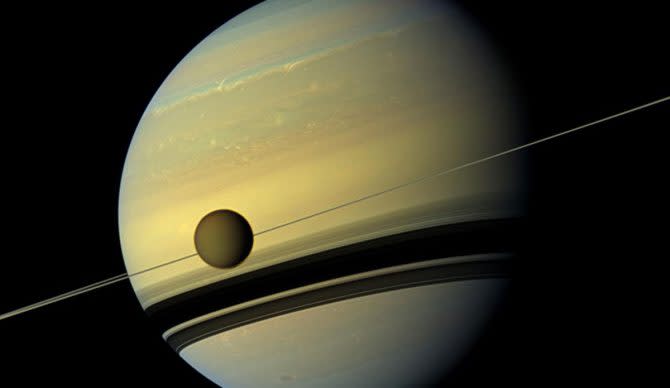Waves on Saturn’s Moon Titan Are Likely Big Enough to Shape Its Shorelines

Saturn has a whole lot of moons. As of last year, there are 146 of them. One, however, stands out among the rest: Titan. A few years ago, scientists staring up at it found something very interesting. It seems as though it has waves. And now, new research appears to suggest that those waves could be powerful enough to shape the shorelines of lakes and seas on Titan.
Before you get too excited about the prospect of interplanetary surf trips, those bodies are not exactly swimmable. Setting aside the fact that the average temperature there is nearly 300 degrees below zero, the liquid on Titan are made up of liquid hydrocarbons like methane and ethane, which is bad for you skin, to say the least.
It’s a wild place, with an atmosphere made up mostly of nitrogen — similar to Earth’s — but the pressure on the surface is about 50 percent higher than we experience on our pale blue dot. Researchers have taken great interest in Titan because they believe it closely resembles what Earth may have been like in its earliest stages.
“Titan is the only moon we know of with a substantial atmosphere, and one that is more similar to Earth’s than the wispy near-nothings of Mars or the boiling acidic hell of Venus,” NASA writes. “That atmospheric pressure allows lakes and seas of molecules that are liquid far below the freezing point of water, fed by rivers from hydrocarbon rains on higher ground.”
NASA is currently preparing for the Dragonfly Mission, which seeks to find out more about the giant moon from an up-close-and-personal perspective. The new findings will likely serve to tweak that mission at least a little bit.
One researcher who has long been hyper-focused on Titan is MIT’s Professor Taylor Perron. He’s been studying whether or not large waves actually form on Titan.
“We can say, based on our results, that if the coastlines of Titan’s seas have eroded, waves are the most likely culprit,” Perron said in a statement. “If we could stand at the edge of one of Titan’s seas, we might see waves of liquid methane and ethane lapping on the shore and crashing on the coasts during storms. And they would be capable of eroding the material that the coast is made of.”
When scientists first had a glimpse of Titan’s lakes and seas, they believed they were, for the most part, as smooth as glass. Others, however, thought there simply must be.
“Some people who tried to see evidence for waves didn’t see any, and said, ‘These seas are mirror-smooth,’” said Rose Palerm, who is the first author of the paper published in Science Advances. “Others said they did see some roughness on the liquid surface but weren’t sure if waves caused it.”
While it’s not entirely confirmed as of this writing, it does seem likely that waves on Titan are large enough and powerful enough to shape the shorelines of the famous moon.
The post Waves on Saturn’s Moon Titan Are Likely Big Enough to Shape Its Shorelines first appeared on The Inertia.

